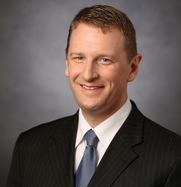 Chad Leqve, a 22-year veteran of the Metropolitan Airports Commission (MAC), has been named its new vice president – management and operations.
In that role, Leqve will oversee day-to-day operation of all seven MAC Airports: Minneapolis-St. Paul International (MSP), Airlake, Anoka County-Blaine, Crystal, Flying Cloud, Lake Elmo, and St. Paul Downtown.
Previously, Leqve was director of the MAC Environment Department, helping the MAC earn a reputation as an industry leader in aircraft noise mitigation, developing innovative approaches to noise measurement, data collection and communication, and fostering collaboration among airlines, community representatives and Federal Aviation Administration officials.
Under Leqve’s leadership, the department also created a tool to measure local impacts of new aircraft arrival procedures, achieved Level 2 Airport Carbon Accreditation from Airports Council International, and strengthened water and air quality protections.
“Chad is uniquely qualified to lead the MAC’s Management and Operations Division,” said MAC Chief Operating Officer Roy Fuhrmann. “Over the course of the past two decades, Chad has focused on airfield runway use, capacity and safety; environmental leadership; stakeholder engagement; and bringing airlines, the Federal Aviation Administration and community leaders together to address concerns collaboratively. A licensed pilot, Chad knows airport operations from both a professional and user standpoint. And his commitment to innovative problem solving will provide a competitive edge in keeping our airport system among the nation’s best.”
As vice president, Leqve will oversee a division that includes the Field Maintenance and Airside Operations, Landside Operations, Facilities, and Terminal 2 Operations departments at MSP. The division also includes the Reliever Airports Department.
“The leaders and employees in the MAC’s Management and Operations Division are a true testament to what makes this organization an industry leader,” Leqve said. “I am honored and excited to partner with them and our airline and federal partners in continuing the MAC’s tradition of excellence at MSP and the reliever airport system.”
A graduate of St. Cloud University with a bachelor’s in aviation management, Leqve has been involved in a variety of industry leadership roles and activities through Airports Council International-North America (ACI-NA), the Transportation Research Board, Radio Technical Commission for Aeronautics, NextGen Joint Planning and Development Office, University of California Davis Annual Noise and Emission Symposium Coordinating Committee, FAA Local Area Augmentation System Government and Industry Partnership Benefits Advocacy Action Planning Group, and American Association of Airport Executives (AAAE).
He has also received a number of prestigious awards, including: the AAAE and ACI-NA Randy Jones Award for Excellence in Airport Noise Mitigation, Abatement and Management; the Environmental Achievement Award – Innovative and Special Projects from Airports Council International-North America; Airport Business’ Top 40 Under 40 Award; and the Outstanding Achievement Award for Community and Public Outreach from the Federal Aviation Administration.
Leqve resides in Lakeville with his wife, two sons and daughter.
|
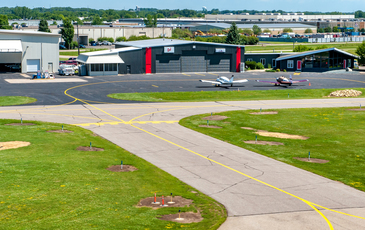 Summer fun for aviation buffs continues at the MAC's reliever airports, with two more events set for July.
AirExpo 2018 will take place at Flying Cloud Airport on July 14 and 15.
The event features a large number of vintage aircraft on display and more than 35 VIPs with a wide range of flying experience will be on hand as well.
One of those expected to attend is Col. Richard Cole, the last survivor of the Doolittle Raid on Tokyo in 1942. He served as Doolittle's co-pilot.
Details about the weekend at Flying Cloud are available at this website.
Also that weekend, on Sunday, July 15, the Lakeville Lions Club will host the Airlake Fly-In Breakfast at Airlake Airport in Lakeville.
The breakfast starts at 8 a.m. and will feature an appearance by the Minnesota Commemorative Air Force "War Birds."
More information is available at this website.
|
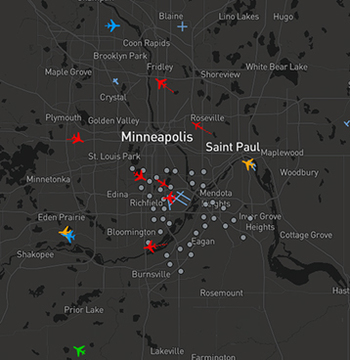 The online flight tracker on www.macnoise.com recently received a complete makeover that went live last week.
The Flight Tracker has long been popular with aviation enthusiasts and residents near Minneapolis-St. Paul International Airport (MSP) for monitoring flights and noise levels.
But the new website offers enhanced features including a mobile-device friendly interface, the capability to see each flight's real-time speed and altitude, and find a noise level from the MAC sound-monitoring devices located in neighborhoods near the airport.
"The new flight tracker takes MSP to the next level with its presentation of user-friendly data," said Dana Nelson, the MAC's noise manager. "The MAC is continually working to make flight data accessible to the public."
New features of the redesigned flight tracker include:
- Users can view all flights in a certain timespan that they select, but with much more data on individual flights than was previously available. Flight speed, altitude, aircraft type, airline and flight number, origin and destination are all available in a small box next to each flight on the map.
- Type in your address or drop a pin on the map, and the tracker tells you how close an aircraft is to you, recorded in tenths of a mile, such as 1.2 miles. If the plane is less than a mile away, the measurement is given in feet (5,280 feet in a mile).
- In the animated view, users can see all the data from the noise-monitoring stations. As a plane flies over a monitor, a color-coded graphic indicates the decibel measurement.
- Users can also draw a "gate," or a line on the map. Any flight that crosses that line will generate statistics for the user. The number of flights, their altitude and when the airplane passed over are all available.
- The website will also provide daily bar charts, noting how many airplanes flew each hour and how MSP's runways were configured for air traffic at the time. Wind direction typically determines in which direction airplanes are taking off and landing.
- The new flight tracker will also capture data on some flights at the MAC's six reliever airports, depending on what data from each flight is available to the tracking system.
The launch of a newly redesigned Flight Tracker coincides with the move of all MACNOMS infrastructure into the cloud using Amazon Web Services.
More information about the MAC's Noise Program Office is available at this website.
|
Aviation buffs will have the chance to be a part of history next month when the Ford Tri-Motor arrives at the St. Paul Downtown Airport. The Experimental Aircraft Association Chapter 54 will be offering rides on its Tri-Motor in St. Paul July 5-8.
The Tri-Motor, a 1920s-era aircraft, was produced by Henry Ford after he bought the Stout Metal Airplane Co. A total of 199 Tri-Motors were produced.
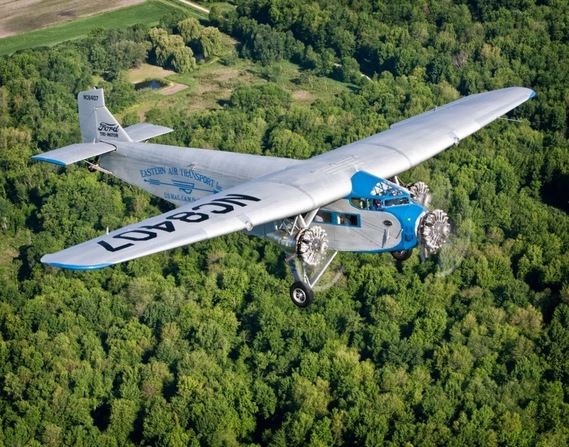
Advance prices for a sight-seeing flight are $70 for an adult and $50 for children 17 and under. Walk-up pricing is $75, and advance purchases are recommended.
To book a sight-seeing flight visit FlytheFord.org.
A video with additional information about the Ford Tri-Motor can be seen here.
(Editor’s note: Following is the fifth in a series of articles regarding how the Metropolitan Airports Commission came into being 75 years ago, and how the commission’s airport system has evolved over the decades.)
The opening of the new terminal at Minneapolis-St. Paul International Airport in 1962 only marked the beginning of a period of sustained growth.
Passenger numbers continued to increase as more people were drawn to the Twin Cities metro area, and the airlines augmented their flight schedules during the 1960s with more routes served by new, faster jets.
To handle the larger planes, the south parallel runway had been extended to 10,000 feet by the end of 1961.
Braniff Airlines began flying Boeing 720B jets from MSP to Mexico City in 1961, and Western and United followed soon after with additional jet service of their own.
Northwest had earlier introduced service on DC-8s and continued to upgrade its jet fleet throughout the decade. By the early 1970s, Northwest Airlines’ fleet included 15 Boeing 747s and 14 Douglas DC-10s.
After the new terminal opened at MSP, construction projects also began to dot the airfield.
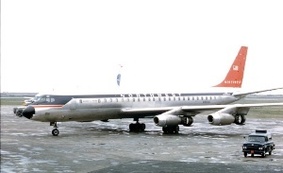 North Central Airlines broke ground in 1967 on a new $17 million main base and headquarters on the south end of the airfield, which opened in 1969. Northwest started work in 1969 on an $18 million hangar expansion to service 747s and DC-10s.
Pictured: A Northwest Airlines DC-8.
A new concourse opened in 1968 for “transient” aircraft, those operated by airlines that weren’t based at MSP.
The continuing growth wasn’t without complications.
Aircraft noise had been a simmering issue for more than 20 years. In fact, records of public hearings in Minneapolis in 1947 show that when airport leaders discussed the idea of a secondary airport located in Anoka County, people at the hearing spoke against any further expansion at MSP due to noise.
For the MAC’s leadership, the boom in passenger numbers came to a head in 1967. An FAA forecast on air travel showed that by 1980, MSP wouldn’t have sufficient capacity to meet passenger demand.
At the same time, as jets became common in the skies over the Twin Cities, neighborhood activism increased.
A Minneapolis City Council meeting in 1968 drew 400 people demanding the passage of an ordinance banning air travel over the city.
The ordinance wasn’t enacted, but that type of community pressure led to the formation of the Metropolitan Aircraft Sound Abatement Council (MASAC) in 1969. The council included 13 public representatives and 13 from the airlines.
The MASAC worked collaboratively to come up with several procedures to reduce aircraft noise near the airport. The group’s efforts led to a reduction in the number of training flights at MSP and contributed to the addition of a noise abatement specialist to the MAC staff. Later, the MAC also established a noise abatement hotline to handle complaints.
In the years that followed, the MAC would work with the community to implement a noise program – including extensive mitigation efforts – that would become a national leader known for its innovation and responsiveness.
|
 A North Central Airlines ad from 1969.
The Ham Lake proposal
Given the backdrop of demand for more flights and noise concerns from surrounding neighborhoods, the MAC began a search for a new airport location. Leaders looked for a large site located far away from residential areas, while also allowing the MAC to finance the project with existing sources of revenue.
Studies of the Twin Cities area soon identified a site in Ham Lake, an undeveloped area located about five miles north of Blaine.
The site was located northeast of the intersection of Hwy. 65 and Bunker Lake Road, and bounded by the Carlos Avery Wildlife Management Area to the east.
In the late 1960s, even though the city of Blaine was in the early stages of planning, its build-out had not even begun. And compared to the south metro, there was less demand from developers in the far northern suburbs due to the presence of scattered wetlands.
There were four public hearings in 1968 following the MAC’s announcement of its intent to build a new airport in Ham Lake.
The City of Anoka and the Anoka Chamber of Commerce supported the plan. Spring Lake Park and Columbus Township – which is located near the actual site – opposed it.
The Ham Lake town board voted to seek to delay the project and asked the State Legislature to examine what was behind the state’s intent when it created the MAC back in 1943.
The planning continued and the MAC began working to have its jurisdictional area of a 25-mile radius from the core of both Minneapolis and St. Paul increased to 35 miles. That change ultimately became law in 1974.
Also in 1969, the Minnesota Legislature took up three separate bills from 13 different metro area legislators, two of the bills dealing solely with the composition of the MAC’s board of commissioners. The suburbs wanted more of a voice in the operation of MSP and plans for the future.
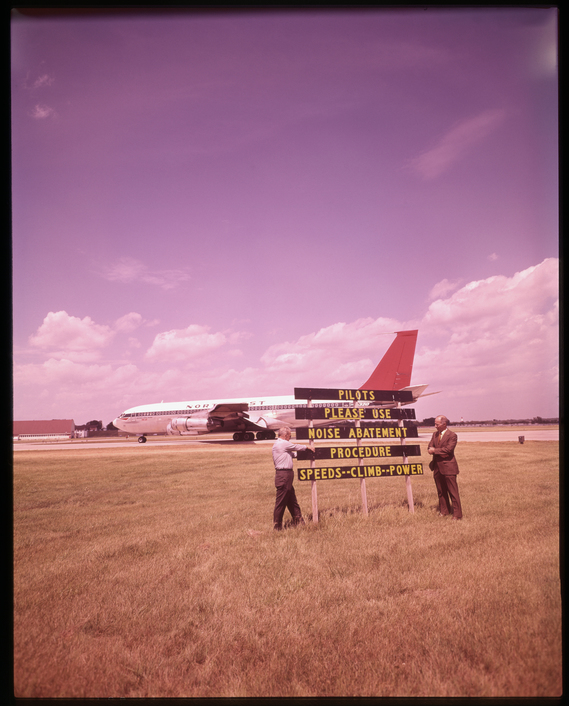 An early noise abatement procedure reminder at MSP.
None of the bills passed, but the ball had started rolling for broader representation on the MAC’s board.
Ultimately, the more powerful opposition to the Ham Lake plan came from the Metropolitan Council, which had been established in 1967, and from the airlines serving MSP.
The Met Council had a key role in long-term planning in the metro area, and expressed concerns about environmental impacts to the Ham Lake area and plans to finance the new airport.
From 1948 to 1958, the MAC issued bonds totaling $10.2 million to pay for construction and other projects, which were paid for by property owners in the cities of Minneapolis and St. Paul. But as the 1960s progressed, the airport embraced a self-funding model that relied exclusively on rents or fees collected at the airport.
The airport’s existing revenue stream was used by the MAC to operate MSP, and questions arose about whether that income could simultaneously support the issuance of bonds to build a new airport. Some area leaders argued that the MAC’s ability to tax property would need to be expanded more broadly in the metro area to build in Ham Lake.
The airlines were initially cool to the idea of a new airport. Many of the airlines had recently invested in new facilities at MSP and weren’t anxious to make a move north. Also, airline leases to operate at MSP weren’t open for renegotiation until the summer of 1973.
As the Ham Lake plans progressed, Northwest Airlines sent a telegram to the MAC's Board of Commissioners, threatening to stop a $22 million construction project at MSP. (See photo below.)
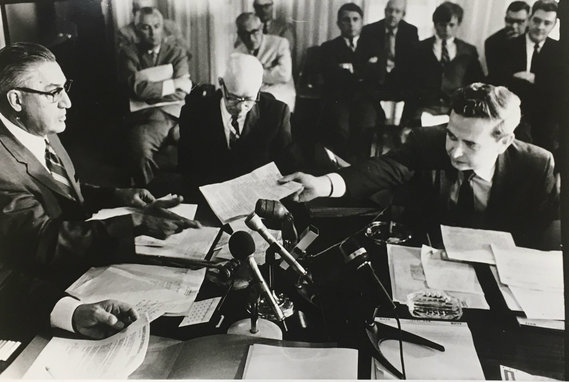 St. Paul Mayor Thomas Byrne hands Northwest Airlines' telegram to MAC Chairman Lawrence Hall in a 1969 meeting. In the middle is Kenneth Osterberg, the MAC’s negotiator with the airline.
Also at issue: the distance of any new airport from the urban center. A 1970 consultant’s report, done for the MAC, noted that “if the (new) airport is over 30 miles from the city center, there is difficulty making the airport an integral part of the community."
MSP’s location provides convenience for its users, and the drive time to any new airport and its proximity to jobs and housing also needed to be considered, the report noted.
In votes taken in both 1969 and 1970 on proposals from the MAC, the Metropolitan Council vetoed plans to build a second commercial airport at Ham Lake.
In 1972, after further negotiations, the MAC and the Metropolitan Council did reach an agreement on the Ham Lake site.
A few things had changed by that time. A mild recession that began in 1969 led to doubts about forecasted growth in passenger numbers, and the airlines’ opposition to Ham Lake had only increased.
Ultimately, the MAC decided not to move forward with the Ham Lake plan. Today, the Ham Lake area considered for a new airport is full of subdivisions with residential homes.
The idea of relocating the airport would be revisited 20 years later, as the airline industry and the airport continued to grow.
In 1989, the Minnesota Legislature passed the Metropolitan Airport Planning Act. That began a process that evaluated whether to expand MSP at its existing site or build a new airport farther away from the Twin Cities’ core.
Future stories in this monthly series will provide more detail on that era of airport planning.
Hollywood comes to MSP
The filming of the blockbuster movie “Airport” at MSP in 1969 shed a different light on the airport.
The film, which became the first in the 1970s genre of disaster films, had a big cast with big names including Dean Martin, Burt Lancaster and Jacqueline Bisset.
The plot lines included an airport manager (Lancaster) trying to keep a fictional Chicago-area airport open during a snowstorm. Also, a passenger aboard the plane -- where Martin is the co-pilot -- threatens to blow up the aircraft.
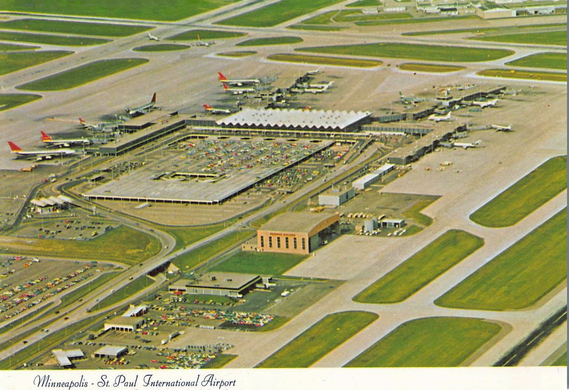 Above: MSP's terminal 1 in the early 1970s.
MSP was picked as the key filming location largely for its winter weather. However, when filming started the weather didn’t cooperate. Many MAC snowplow operators were involved in filming snow scenes, but film director George Seaton had to use plastic pellets of “snow” to simulate a blizzard.
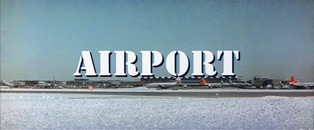 The climactic scene features a landing in a plastic snowstorm at MSP, which you can watch here.
The movie received a lukewarm reception from critics, but audiences loved it.
Costing $10 million to produce, the film’s box office was more than $100 million, making it the second-highest grossing film of 1970. Helen Hayes, who portrayed a stowaway on the plane, won an Oscar for Best Supporting Actress. The film was also nominated for several other Academy Awards, including Best Picture.
More changes coming for MSP in the 1970s and beyond
Compared to today’s airline industry, air travel in the early 1970s was still a novelty for most Americans.
Estimates from 1973 show that no more than 20 percent of Americans had ever flown on an airplane. Flights were relatively expensive and far-flung vacations were not the norm.
By the year 2000, 50 percent of Americans had taken at least one round-trip flight in the last year. In addition, the number of air passengers in the US would triple between the early 1970s and 2011, continuing a fast pace of change for airlines and airports.
Sources for this article:
Minnesota Historical Society Archives.
MAC meeting minutes.
Speas Associates report, 1970.
"America's North Coast Gateway," by Karl Bremer.
|
Board Meetings
Business Opportunities
Career Opportunities
General Aviation Airport Information
MSP Aircraft Noise Information
MSP Airport
|